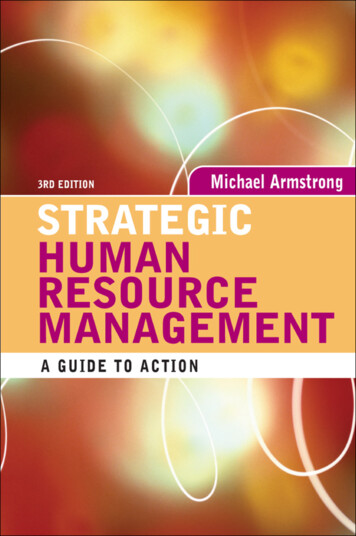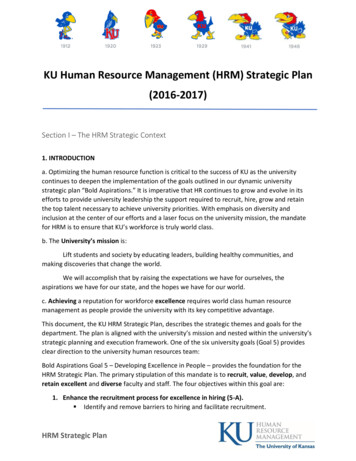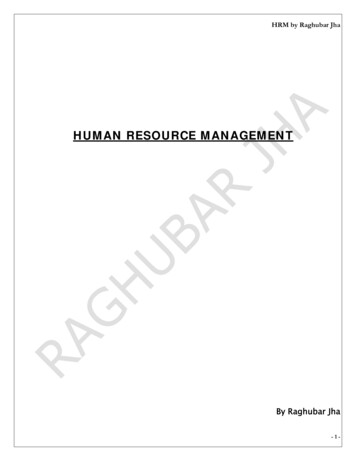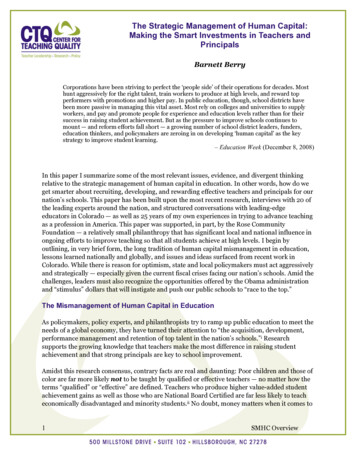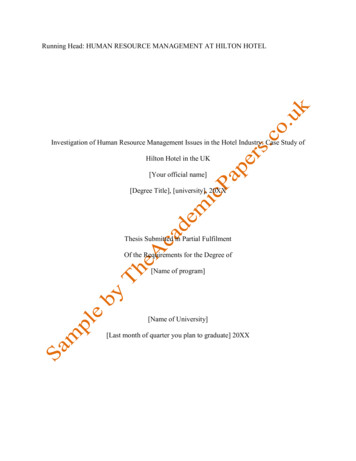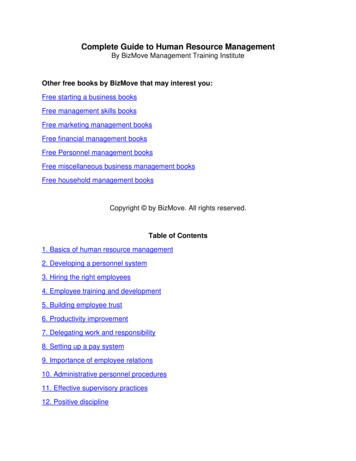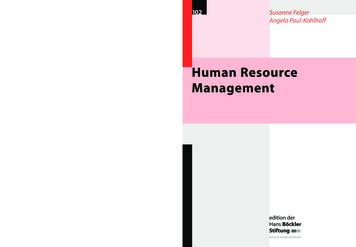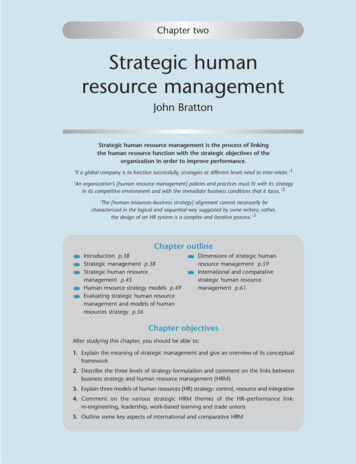
Transcription
Chapter twoStrategic humanresource managementJohn BrattonStrategic human resource management is the process of linkingthe human resource function with the strategic objectives of theorganization in order to improve performance.‘If a global company is to function successfully, strategies at different levels need to inter-relate.’ 1‘An organization’s [human resource management] policies and practices must fit with its strategyin its competitive environment and with the immediate business conditions that it faces.’ 2‘The [human resources–business strategy] alignment cannot necessarily becharacterized in the logical and sequential way suggested by some writers; rather,the design of an HR system is a complex and iterative process.’ 3Chapter outlineIntroduction p.38Strategic management p.38Strategic human resourcemanagement p.45Human resource strategy models p.49Evaluating strategic human resourcemanagement and models of humanresources strategy p.56Dimensions of strategic humanresource management p.59International and comparativestrategic human resourcemanagement p.61Chapter objectivesAfter studying this chapter, you should be able to:1. Explain the meaning of strategic management and give an overview of its conceptualframework2. Describe the three levels of strategy formulation and comment on the links betweenbusiness strategy and human resource management (HRM)3. Explain three models of human resources (HR) strategy: control, resource and integrative4. Comment on the various strategic HRM themes of the HR–performance link:re-engineering, leadership, work-based learning and trade unions5. Outline some key aspects of international and comparative HRM
38Human Resource ManagementIntroductionIn the first chapter, we examined the theoretical debate on the nature and significanceof the human resource management (HRM) model; in this chapter we explore anapproach to HRM labelled strategic human resource management, or SHRM. By astrategic approach to HRM, we are referring to a managerial process requiring humanresource (HR) policies and practices to be linked with the strategic objectives of theorganization. Just as the term ‘human resource management’ has been contested, sotoo has the notion of SHRM. One aspect for debate is the lack of conceptual clarity(Bamberger & Meshoulam, 2000). Do, for example, the related concepts of SHRM andHR strategy relate to a process or an outcome?Over the past decade, HR researchers and practitioners have focused their attentionon other important questions. First, what determines whether an organization adoptsa strategic approach to HRM, and how is HR strategy formulated? Of interest is whichorganizations are most likely to adopt a strategic approach to HRM. Is there, forexample, a positive association with a given set of external and internal characteristicsor contingencies and the adoption of SHRM? Another area of interest concerns thepolicies and practices making up different HR strategies. Is it possible to identify acluster or ‘bundle’ of HR practices with different strategic competitive models? Finally,much research productivity in recent years has been devoted to examining the relationship between different clusters of HR practices and organizational performance.Does HR strategy really matter? For organizational practitioners who are looking forways to gain a competitive advantage, the implication of HR strategic choices forcompany performance is certainly the key factor.Before, however, we look at some of the issues associated with the SHRM debate, weneed first to examine the strategic management process. This chapter also examineswhether it is possible to speak of different ‘models’ of HR strategy and the degree towhich these types of HR strategy systematically vary between organizations. We thenconsider some issues associated with SHRM, including international and comparativeSHRM. As for the question of whether there is a positive association between differentHR strategies and organizational performance, we are of the opinion that, given theimportance and volume of the research surrounding this issue, the topic warrants anextended discussion (Chapter 13). In the current chapter, we address a number ofquestions, some essential to our understanding of how work organizations operate inthe early 21st century work and the role of HRM therein. How do ‘big’ corporate decisions impact on HRM? Does the evidence suggest that firms adopting differentcompetitive strategies adopt different HR strategies? How does HRM impact on the‘bottom line’? There is a common theme running through this chapter, much of theHR research pointing out that there are fundamental structural constraints that attestto the complexity of implementing different HRM models.Strategic managementThe word ‘strategy’, deriving from the Greek noun strategus, meaning ‘commander inchief’, was first used in the English language in 1656. The development and usage ofthe word suggests that it is composed of stratos (army) and agein (to lead). In amanagement context, the word ‘strategy’ has now replaced the more traditionalterm – ‘long-term planning’ – to denote a specific pattern of decisions and actions
Strategic Human Resource Management39Senior managementEnvironmentResourcesFigure 2.1 The three traditional poles of a strategic planSource: Adapted from Aktouf (1996)undertaken by the upper echelon of the organization in order to accomplish performance goals. Wheelen and Hunger (1995, p. 3) define strategic management as ‘that setof managerial decisions and actions that determines the long-run performance of acorporation’. Hill and Jones (2001, p. 4) take a similar view when they define strategyas ‘an action a company takes to attain superior performance’. Strategic managementis considered to be a continuous activity that requires a constant adjustment of threemajor interdependent poles: the values of senior management, the environment, andthe resources available (Figure 2.1).HRM IN PRACTICE 2.1STRATEGY PLANNING HAS SUDDENLY GOT SEXYGORDON PITT. THE INS AND OUTS OF MANAGEMENT TOOLS. GLOBE AND MAIL, 1998, JANUARY 8In the past decade, the NorthAmerican workplace, as thosein Europe, has seen a constantparade of management fadsand fashions. In 1993, the topthree most popular management techniques were missionstatements, customer satisfaction measurement, and totalquality management. In 1996,strategic planning, missionstatements and benchmarkingwere the top three managementtechniques. Of the 409 NorthAmerican companies surveyed,89 per cent reported using strategic planning in 1996. As onebusiness observer (Pitt, 1998)commented: ‘Strategic planninghas always been around [but] itsuddenly got sexy.’Model of strategic managementIn the descriptive and prescriptive management texts, strategic management appearsas a cycle in which several activities follow and feed upon one another. The strategicmanagement process is typically broken down into five steps:
40Human Resource Management1.2.3.4.5.mission and goalsenvironmental analysisstrategic formulationstrategy implementationstrategy evaluation.Figure 2.2 illustrates how the five steps interact. At the corporate level, the strategicmanagement process includes activities that range from appraising the organization’scurrent mission and goals to strategic evaluation.The first step in the strategic management model begins with senior managers evaluating their position in relation to the organization’s current mission and goals. Themission describes the organization’s values and aspirations; it is the organization’sraison d’être and indicates the direction in which senior management is going. Goalsare the desired ends sought through the actual operating procedures of the organization and typically describe short-term measurable outcomes (Daft, 2001).Environmental analysis looks at the internal organizational strengths and weak-STEP 1Mission and goalsManagement philosophyValuesSTEP 2Environmental analysisInternal scanExternal scanSTEP 3Strategic formulationStrategic choiceCorporateBusinessFunctionalSTEP 4Strategy implementationLeadershipStructureControl systemsHuman resourcesSTEP 5Strategy evaluationOperating performanceFinancial performanceFigure 2.2 The strategic management model
Strategic Human Resource Management41nesses and the external environment for opportunities and threats. The factors thatare most important to the organization’s future are referred to as strategic factors andcan be summarized by the acronym SWOT – Strengths, Weaknesses, Opportunitiesand Threats.Strategic formulation involves senior managers evaluating the interaction betweenstrategic factors and making strategic choices that guide managers to meet the organization’s goals. Some strategies are formulated at the corporate, business and specificfunctional levels. The term ‘strategic choice’ raises the question of who makes decisions and why they are made (McLoughlin & Clark, 1988). The notion of strategicchoice also draws attention to strategic management as a ‘political process’ wherebydecisions and actions on issues are taken by a ‘power-dominant’ group of managerswithin the organization. Child (1972, quoted in McLoughlin & Clark, 1988, p. 41)affirms this interpretation of the decision-making process when he writes:[W]hen incorporating strategic choice in a theory of organizations, one is recognizing theoperation of an essentially political process, in which constraints and opportunities arefunctions of the power exercised by decision-makers in the light of ideological values.In a political model of strategic management, it is necessary to consider the distribution of power within the organization. According to Purcell and Ahlstrand (1994,p. 45), we must consider ‘where power lies, how it comes to be there, and how theoutcome of competing power plays and coalitions within senior managementare linked to employee relations’. The strategic choice perspective on organizationaldecision-making makes the discourse on strategy ‘more concrete’ and provides important insights into how the employment relationship is managed.Strategy implementation is an area of activity that focuses on the techniques used bymanagers to implement their strategies. In particular, it refers to activities that dealwith leadership style, the structure of the organization, the information and controlsystems, and the management of human resources (see Figure 1.2 above). Influentialmanagement consultants and academics (for example Champy, 1996; Kotter, 1996)emphasize that leadership is the most important and difficult part of the strategicimplementation process.Strategy evaluation is an activity that determines to what extent the actual changeand performance match the desired change and performance.The strategic management model depicts the five major activities as forming arational and linear process. It is, however, important to note that it is a normativemodel, that is, it shows how strategic management should be done rather thandescribing what is actually done by senior managers (Wheelen & Hunger, 1995). As wehave already noted, the notion that strategic decision-making is a political processimplies a potential gap between the theoretical model and reality.Hierarchy of strategyAnother aspect of strategic management in the multidivisional business organizationconcerns the level to which strategic issues apply. Conventional wisdom identifiesdifferent levels of strategy – a hierarchy of strategy (Figure 2.3):1. corporate2. business3. functional.
42Human Resource ManagementContextualfactorsCorporate-level strategyProduct marketCorporate managementWhat business are we in?Capital marketLabour marketBusinessunit 1TechnologyBusinessunit 2Businessunit 3Business-level strategyHow do we compete?GovernmentpoliciesEuropean UnionpoliciesNorth AmericanFree TradeAgreementpoliciesR&D MarketingManuHumanFinanceresources facturingFunctional-levelstrategyHow do we supportthe business-levelcompetitive strategy?StakeholderinterestsHuman resource management: philosophy, policies,programmes, practices, processes, relationships with managers,non-managers, trade unions, customers and suppliersFigure 2.3 Hierarchy of strategic decision makingCorporate-level strategyCorporate-level strategy describes a corporation’s overall direction in terms of itsgeneral philosophy towards the growth and the management of its various businessunits. Such strategies determine the types of business a corporation wants to beinvolved in and what business units should be acquired, modified or sold. Thisstrategy addresses the question, ‘What business are we in?’ Devising a strategy for amultidivisional company involves at least four types of initiative:establishing investment priorities and steering corporate resources into the mostattractive business units
Strategic Human Resource Management43initiating actions to improve the combined performance of those business unitswith which the corporation first became involvedfinding ways to improve the synergy between related business units in order toincrease performancemaking decisions dealing with diversification.Business-level strategyBusiness-level strategy deals with decisions and actions pertaining to each businessunit, the main objective of a business-level strategy being to make the unit morecompetitive in its marketplace. This level of strategy addresses the question, ‘How dowe compete?’ Although business-level strategy is guided by ‘upstream’, corporate-levelstrategy, business unit management must craft a strategy that is appropriate for itsown operating situation. In the 1980s, Porter (1980, 1985) made a significant contribution to our understanding of business strategy by formulating a framework thatdescribed three competitive strategies: cost leadership, differentiation and focus.The low-cost leadership strategy attempts to increase the organization’s marketshare by having the lowest unit cost and price compared with competitors. Thesimple al
approach to HRM labelled strategic human resource management, or SHRM. By a strategic approach to HRM, we are referring to a managerial process requiring human resource (HR) policies and practices to be linked with the strategic objectives of the organization. Just as the term ‘human resource management’ has been contested, so
